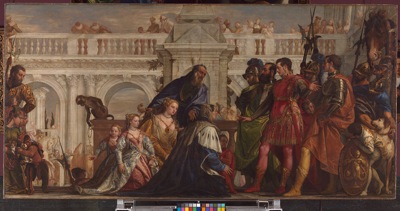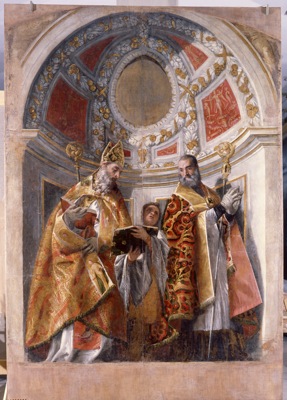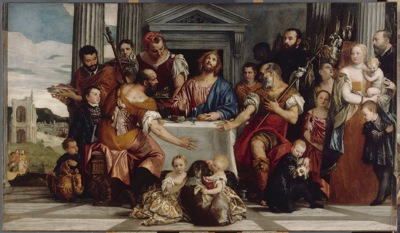
‘This is not painting, it is magic that casts a spell on people who see it,’ said Marco Boschini about Veronese in 1660. Although that is patent nonsense (it clearly is painting, and as Harry Potter was told by Uncle Vernon, there’s no such thing as magic) Boschini’s praise shows that Veronese has not always been in the shadow of the Venetian greats Titian and Tintoretto.
Veronese: Magnificence in Renaissance Venice at the National Gallery is the first UK exhibition of Veronese’s work. Given he died in 1588 that’s quite a wait. This is not the fault of Veronese’s work, which is skilfully composed and executed, showing a great command of colour and medium on large scale canvases. If the blame lies anywhere it is with his antecedents, for not so arranging their generations that his birth occurred during a different period.
Veronese’s problem is that he lived at the same time as Titian and Tintoretto. Art history only needs a couple of examples from each period before it gets bored and moves on and over time the two Ts (as they are not known) have filled Chapter 9: Venetian Renaissance with no room for more than a footnote for our Paolo.
Today though, when galleries cast around ever further for subjects for their entry-fee shows, Veronese has been rediscovered. Fifty of his canvases have been collected together for this show, which is no mean feat, as they are mostly large, mostly 400 years old and mostly the sort of works that don’t travel. OK, ten of these are from the NG’s own collection and only had to be carried from other rooms in the gallery, but the other forty include loans from the Prado and the Louvre. A Martyrdom of Saint George from the artist’s home town of Verona has only previously left its home at San Giorgio when it was nicked by Napoleon. There are other paintings that have never before left their Venetian locations. If you want an in-depth overview of Veronese’s work that will probably never be repeated in your life time, get to the National Gallery.
The exhibition is laid out chronologically, and the gallery has managed to get hold of both the earliest and the latest known works by the artist. The first is from when he was nineteen, and is ‘not bad for an A-Level project,’ as art historian Richard Stemp has commented. His early works do not have the bold control of composition that he quickly develops, but they display his ongoing love of architecture, maybe influenced by his father who was a stonemason. A colleague in some projects of Andrea Palladio, there are periods in Veronese’s career when he didn’t regard a painting as finished unless he had managed to fit in a Roman ruin or two, or a view of Venice.

Veronese, The Family of Darius before Alexander © The National Gallery, London
Anachronisms were not something Veronese avoided. On the contrary a good anachronism was something he embraced. His Family of Darius before Alexander from 1565 is a good example of the approach that allowed him to show off his representational skills. On this large 2.3m by 4.7m canvas Veronese displays his healthy disregard for authenticity. We’re in 333BC – not that you’d know from the costumes that Veronese has carefully recreated. Alexander himself is wearing a Roman outfit. His soldiers have chosen medieval armour. The womenfolk of Darius’ family are garbed in the contemporary fashions of Venice – his wife in a copy of an outfit worn by the Doge’s wife. The architectural background has more than a hint of Palladio, who had designed the Pisani palace near Padua where this picture was to hang.

Veronese, Sts Geminianus and Severus, 1560 Galleria Estense, Modena ©Ministero dei Beni e delle Attività Culturali e del Turismo
Veronese’s large painting of Saints Geminianus and Severus has a clear join down the centre. Two canvases have been converted into one. This large piece was painted as the two parts of an organ screen, showing the jobbing nature of Renaissance artists. Veronese was not creating work for viewing in rarefied art galleries, but filling blank walls with pictures and turning his hand to anything that patrons were pleased to pay for.
The influence of the patron in the final compositions is clear in the Supper at Emmaus, borrowed from the Louvre. This scene is taken directly from the Bible, so we know who is in it. Jesus, two of his followers and possibly the inn keeper would be authentic. To be fair Luke doesn’t explicitly say there aren’t a crowd of onlookers dressed in 16th century Venetian costume, but it’s the kind of thing most of us take for granted. Not Veronese, who was happy to stick the patron’s extended family in as extras, along with the distinctly palatial setting. And of course a ruin…

Veronese, The Supper at Emmaus, Musée du Louvre © RMN (Musée du Louvre)/Gérard Blot
Veronese’s habit of not-exactly-sticking-to-the-Biblical-story earned him a run in with the Inquisition in 1573. He had painted a Last Supper that the catholic church believed lacked respect. Asked to repaint it to make it more Last Suppery, he agreed – but then merely changed the title. A cunning way to get around the claims of heresy, and a bold move given the powers that the Inquisition had. Fool-hardy though it may have been, he got away with it.
So Veronese wasn’t a historian you can rely on. His works are extravagant in size and colour, the characters in his compositions carefully controlled, his love of ruins less so. The opulence of his patrons is clear, but so is Veronese’s skill in rendering the furs and fabrics that they wear. Clothes shimmer in the light he conjures from his oils.
The scale and quantity of the pictures in this show is remarkable, and reminds that Veronese was running a studio system as reliant on assistants as any contemporary artist who specialises in paintings of spots. He influenced artists like Van Dyke, Reubens and Delacroix and now he is being shown for several months in central London he has the chance to influence a few more.
Veronese: Magnificence in Renaissance Venice continues at the National Gallery until 15th June 2014

Hi
“Veronese: Magnificence…” – Interesting article. It says “author’s details are above” – but I can’t find them! Who wrote this piece? Thanks